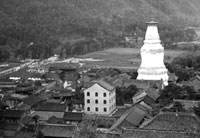|
|
||||
|
Travel to the sacred places of the Shanxi region of China |
||||
|
A detail of the sacred |
The Chinese province of Shanxi, around one thousand kilometres west of Peking, does not usually find space inside the catalogues of normal tour operators. It is however, a corner of China particularly fascinating as it is still untouched by the advances of modernisation and by money, and continues to live immersed in century old traditions. One night by train from Peking, on the same line that connects the Chinese capital with the capital of the Mongolian Republic, Ulan Bator, you arrive in Datong: here stretching a distance of one kilometre along the rock face are the caves of Yungang, around 50 temples carved into the rocks about 1500 years ago. In these cave-temples are around 50 thousand well preserved statues of Buddha - measuring from just a few centimetres to many metres high. Following the vaults of Yingxiang: it is possible to visit the Wooden Pagoda, a 100 metre high structure built in the XI Century, and the Hanging Monastery carved into the leaning walls of Jinglong Canyon. Continuing on the winding roads, you arrive at Taihuai, on the slopes of Wutaishan, the sacred five peaked mountain. On each peak rises a temple, which can be accessed by climbing up seemingly infinite flights of stairs. Buddhists believe that this mountain is the home of Buddha Manjushri. Finally, upon reaching Taiyuan, capital of the Shanxi region, it is possible to go in discovery of the small monastery of Chingshansi and of the Jinci temple complex, consisting of eight beautiful pagodas. |
|||
|
|
||||


